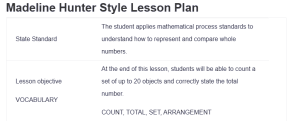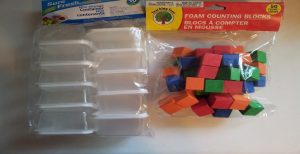Madeline Hunter Style Lesson Plan
| State Standard | The student applies mathematical process standards to understand how to represent and compare whole numbers. |
| Lesson objective
VOCABULARY |
At the end of this lesson, students will be able to count a set of up to 20 objects and correctly state the total number.
COUNT, TOTAL, SET, ARRANGEMENT |
| Materials | Counting manipulatives (e.g., blocks, counters)
Whiteboard and markers Anchor chart with counting strategies Paper for drawing/counting |
| Anticipatory Set
1. Hook 2. Check for previous knowledge 3. State objective of lesson |
Anticipatory Set
1. Show a collection of objects (e.g., 10 blocks) and ask, “How many do I have?” 2. Students show how they count items in their homes (to connect to real-life examples). 3. Explain that we will learn how to count objects accurately. |
| Teaching
1. Input (explain) 2. Model(demonstrate) 3. Check for understanding (how?) |
1. Introduce counting and emphasize that the last number spoken is the total.
Figure 1: Counting blocks 2. Use manipulatives to model counting. Count out loud as you point to each object. 3. Ask volunteers to count objects and confirm their totals. |
| Guided Practice
1. Explain the work 2. Work done in groups, or individually 3. Teacher monitors, helps |
1. Distribute groups of 15-20 manipulatives to small groups.
2. Students will count their objects in groups of 2-3, ensuring they agree on the total. 3. Circulate and provide support, asking questions to encourage discussion about their counting strategies. |
| Closure
1. Students demonstrate knowledge, through questions or presentations 2. Re-state objective of lesson |
1. Have each group share their total and explain how they counted.
2. Reinforce that the last number said is the total number of objects. |
| Independent Practice
1. Work done without teacher help, after guided practice, homework or another time |
Students will draw a set of objects (up to 20) and write the total number underneath. |
| Evaluation
1. What the students can due to prove they understand the objective of the lesson |
Students will be assessed on their ability to accurately count objects and express the total verbally or in writing. |
| Accommodations
1. LD 2. ELL 3. GT |
ORDER A PLAGIARISM-FREE PAPER HERE
We’ll write everything from scratch
Question 
| State Standard | 4th grade (5) Algebraic reasoning. The student applies mathematical process standards to develop concepts of expressions and equations. The student is expected to: (D) solve problems related to perimeter and area of rectangles where dimensions are whole numbers. |
| Lesson objective VOCABULARY |
Objective- At the end of this lesson the student will be able to draw the area of a given rectangle and correctly tell its area. The student will write the equation that shows the area formula for each drawing. AREA, SQUARE FEET, LENGTH, WIDTH |
| Materials | ANCHOR CHART, PAPER WITH RECTANGLES, RULER, GRAPH PAPER, PENS |
| Anticipatory Set 1. Hook 2. Check for previous knowledge 3. State objective of lesson |
1. Show 2 different size rectangles, 2. ask which has a greater area. (do they know what area means in a non-math setting) 3. Today we will be finding the area of rectangles. We will draw them, count the square units, and figure out the mathematical formula. |
| Teaching 1. Input (explain) 2. Model(demonstrate) 3. Check for understanding (how?) |
1. Anchor chart- show how to find the area of a rectangle, stress the idea of squared unit- it could be a foot or a cm., area is always done with square units. 2. On a paper, show how to find the area. We will use inches. Have a pre-done rectangle (no half inches for this!) Show how to mark off on the length and the width and draw the squares. Then count off the squares. Here is what it might |

Madeline Hunter Style Lesson Plan
| look like. 3. Students will fill in a preprinted rectangle as I did in the demonstration. |
|
| Guided Practice 1. Explain the work 2. Work done in groups, or individually 3. Teacher monitors, helps |
1. Pass graph paper, explain that each square will count as a square inch. Have the following 7 questions on the board. Demonstrate drawing and counting the first one. What is the area of a rectangle that has the following dimensions? 1. H-3, W-2 2. H-5, W-6 3. H-1, W-8 4. H-7, W-3 5. H-4, W-6 6. H-8, W-5 7. H-3, W-10 2. The work will done individually, though they can help each other. 3. Teacher monitors and asks if there is an easier way. |
| Closure 1. Students demonstrate knowledge, through questions or presentations 2. Re-state objective of lesson |
1. Contest- A select student write the dimensions of a rectangle on the board and the first student to know the area stands up. The select student and teacher pass around to see the answer of all the students who finish. The first student who got it will explain how he/she got the answer so quickly (and show us the equation). Then all students will write the formula for their own rectangles and the select student and teacher will facilitate. 2. Today we were able to find the how many square feet make up the area of a rectangle and write the formula, HxW=A |
| Independent Practice 1. Work done without teacher help, after guided practice, homework or another time |
n/a |
| Evaluation 1. What the students can due to prove they understand the objective of the lesson |
Students were able to draw the area of a given rectangle and correctly tell its area. The student will write the equation that shows the area formula for each drawing. |
| Accommodations 1. LD 2. ELL 3. GT |
n/a |

